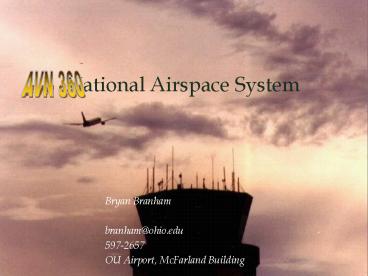National Airspace System - PowerPoint PPT Presentation
1 / 27
Title:
National Airspace System
Description:
To increase capacity and avoid flight delays. Key distinction between IFR and VFR ... Radar tracking. Pilot reports. Syllabus 'Hands-On' Class. Learn basic ATC ... – PowerPoint PPT presentation
Number of Views:1333
Avg rating:3.0/5.0
Title: National Airspace System
1
National Airspace System
AVN 360
Bryan Branham branham_at_ohio.edu 597-2657 OU
Airport, McFarland Building
2
Course Overview
- Introductions
- What is the National Airspace System?
- Syllabus
3
What is the National Airspace System?
4
Definition of NAS
The National Airspace System (NAS), commonly
referred to as the Air Traffic Control (ATC)
system, comprises the network of airports,
airspace, navigational facilities, aeronautical
charts, regulations, procedures, air traffic
control facilities and manpower that collectively
make safe and efficient air transportation
possible within the U.S.
- NAS is much more than airspace
- ATC is much more than controllers
- NAS and ATC are interchangeable
5
Purpose of ATC
- Maintain safe and efficient SEPARATION between
airplanes
6
Safety
To avoid mid-air collisions
PSW B-727 midair with C-172, San Diego, CA, 1978
7
Efficiency
To increase capacity and avoid flight delays
8
Key distinction between IFR and VFR
- IFR (Instrument Flight Rules)
- Separation maintained by controller
- VFR (Visual Flight Rules)
- Separation maintained by pilot (see and avoid)
9
ATC then Exists to
- Separate IFR aircraft
- Where do VFR aircraft fit?
10
What is the Purpose of Airspace Classification?
- To protect IFR traffic fromVFR traffic!
- How?
- Weather minima
- Other restrictions
Paul Harvey
11
Minimum Separation Standards
Hockey puck space around each airplane
Examples changes in altitude, heading, aispeed,
holding pattern
12
How ATC Separates IFR Traffic
- Communications
- Controller-pilot (two-way radio)
- Controller-controller (handoff)
- Navigation
- Own-navigation (navaids)
- Radar vectors
- Surveillance
- Radar tracking
- Pilot reports
13
Syllabus
14
Hands-On Class
- Learn basic ATC concepts in class
- Apply these principles
- Computer simulation of ATC
- Observation of live ATC operations
15
Objectives
- Describe key historical events that have shaped
the present National Airspace System - Describe basic equipment, procedures and verbal
commands used by ATC to separate air traffic - Monitor and interpret live ATC communications
between air traffic controllers and pilots - Assume the role of an air traffic controller in a
simulated radar environment
16
Course Conduct
- Lectures
- First half of course
- Six lectures (chapters 1, 5, 6, 8, 9)
- ATC laboratory
- Second half of course
- ATC Simulator
- 10 radar stations
- Homework assignments
- ATC simulation
- ATC communications
17
Lecture Topics
- 1 Course overview
- 2 History of Air Traffic Control (Ch. 1)
- 3 ATC Procedures and Organization (Ch. 5)
- 4 Control Tower Procedures (Ch. 6)
- 5 Theory Fundamentals of Radar (Ch. 8)
- 6 Radar Separation (Ch. 9)
- 7 ATC Simulator demonstration
18
ATC Simulator
ARTS IIIa
STARS
19
ATC Laboratory
- Stocker 308
- 10 radar stations
- Two students per station
- Class divided into two groups
- Six lab sessions
- Final laboratory simulation evaluation
20
Homework Assignments
- ATC Simulation
- Select one TRACON
- Complete four (4) scenarios with score of 70 or
better - ATC Communications
- Listen ATC audio-feeds online
- Simultaneously view ATC radar-feeds online
- Monitor and interpret six (6) recorded sessions
21
Field Trip ?
- Port Columbus TRACON
- Friday or weekend Jan 27 ?
- Details and dates will be posted on website
22
Preferred Experience
- AVN 110 (required)
- Computer/internet
- See me
23
Required Text Materials
- Text Fundamentals of Air Traffic Control
- ATC Simulator 2.0 software
- ATC Simulator user manual
24
Course Website
- http//mead.citl.ohiou.edu/
- Syllabus
- Lecture outlines
- Homework assignments
- Internet ATC resources
- Communication
25
Assessment and Policies
- Grades
- Grading policy
- Attendance
- Classroom demeanor
- Academic honesty
26
Schedule
27
Next
- History of Air Traffic Control
- Read CHAPTER 1
- Laboratory lessons
- Read lesson OUTLINE in Website































